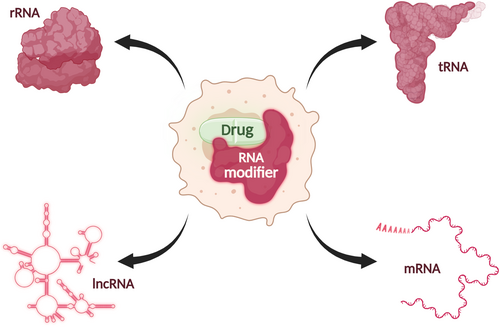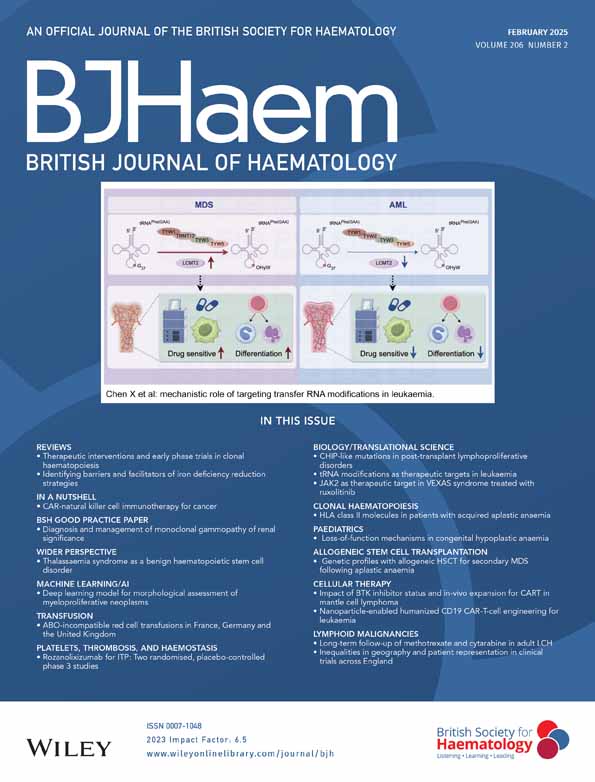Targeting RNA modifications in leukaemia: Epitranscriptomic drugs are the new kids on the block
Abstract
In this article, Chen et al. show that a chemical modification of transfer RNA, along its corresponding RNA modifier enzyme, is diminished in acute myeloid leukaemia. These findings further support the role of an aberrant epitranscriptome in haematological malignancies.
Commentary on: Chen et al. Hydroxy-wybutosine tRNA modifications as indicators of disease progression and therapeutic targets in leukemia. Br J Haematol 2025; 206:517-530.
The DNA sequence provides the ‘hardware’ of our genetic information, which is filtered by the ‘software’ of the epigenetic landscape, including DNA methylation and histone modifications. Recently, a third player has gained attention in the genotype-to-phenotype relationship: the pattern of chemical modifications on RNA. This field, broadly known as epitranscriptomics, is exceptionally complex due to the vast number of distinct potential modifications and the variety of existing transcripts. Chen et al. reported that a specific alteration in the transfer RNA epitranscriptome could be reduced in vitro in leukaemia and that the low levels of its associated enzymatic writer may be linked to poor outcomes. These findings align with growing evidence indicating a significant distortion in the RNA modification landscape in haematological malignancies. Importantly, this aberrant scenario might eventually be reversible through the use of epitranscriptomic drugs, which are now being tested in ‘first-in-class’ clinical trials.
The genetic sequence provides instructions for cellular and tissue functionality. In this context, mutations and other genomic defects, such as chromosomal translocations, contribute to the transformation of normal cells into tumoral ones. However, equally important in carcinogenesis is the incorrect interpretation of the genomic blueprint, which is associated with disrupted DNA methylation and histone modification profiles as part of the epigenetic setting.1 Thus, haematological malignancies exhibit both genetic and epigenetic defects in their origin and progression.1 Recently, another player has entered the tumorigenesis stage: an aberrant distribution of the chemical marks that decorate RNA molecules, which also contributes to leukaemia, lymphoma and other blood-related cancers.2 The so-called epitranscriptome—comprising global marks that regulate RNA stability, protein translation efficiency, splicing and export—includes many modifications. These range from the most common mark in mRNA, N6-methyladenosine (m6A), to more specific ones, like the modification studied by Chen et al.3 that appears only in a subset of transfer RNAs (tRNAs). Such modifications, which also occur in other RNA molecules critical for homeostatic cell activity, like ribosomal RNA (rRNA), are vital for differentiation in haematological malignancies, as has been demonstrated for m6A in both acute myeloid4 and lymphoid5 leukaemia. Most importantly, genes encoding the writers, erasers and readers of these RNA marks are increasingly found to be disrupted in a wide range of human tumours.6
In their study, Chen et al.3 examined acute myeloid leukaemia (AML) cell lines, including one derived from a transformed myelodysplastic syndrome (MDS) patient, to analyse the expression of enzymes involved in modifying a guanine (G) at position 37 (G37), adjacent to the anticodon of phenylalanine tRNA (tRNAPhe). tRNAs are among the RNA molecules with the highest number of modifications, some of which are rare and unique to these specific transcripts.7 Following processing by various enzymes, the G37 residue is transformed into a wybutosine (yW)-derived nucleoside, which is essential for maintaining ribosomal reading frames and ensuring translation fidelity.7 Proper hypermodification of G37 is crucial to prevent ribosome frameshifting events, as it stabilizes codon-anticodon pairing. Interestingly, nearly half a century ago, researchers observed that this hypermodified G37 was lost in hepatoma, conferring a growth advantage to these cells.8 After decades of work by many researchers identifying the proteins involved in this pathway, it was recently shown that epigenetic silencing of the enzyme TYW2 (also known as TRMT12) induces hypomodification of G37 in some tumours, such as colon, cervical and gastric carcinomas.9 Cancer cells with promoter CpG island hypermethylation and TYW2 inactivation undergo ribosomal frameshifts, altering the reading frame and triggering nonsense-mediated mRNA decay.9 This mechanism allows transformed cells to eliminate tumour suppressor genes. In leukaemia cell lines, Chen et al.3 identified a potential reduction of hydroxy-wybutosine (OHyW) using mass spectrometry, possibly due to low levels of the G37 processing enzyme LCMT2 (also known as TYW4). Their in silico analysis of The Cancer Genome Atlas (TCGA) database for AML suggests that reduced expression of this enzyme correlates with poorer outcomes and increased resistance to therapeutic and differentiation treatments. While these findings are intriguing, further validation using clinical samples and additional functional studies are necessary to clarify the role of LCMT2 in haematological malignancies. Nonetheless, this study adds to the growing evidence of altered patterns of RNA modifications in neoplasms.
Beyond understanding how the epitranscriptome contributes to cancer biology and exploring its potential as a biomarker for disease diagnosis and prognosis, RNA modifications represent an exciting frontier for drug development.10 The goal would be to create compounds that block the active sites of RNA ‘writers’ that excessively modify transcripts promoting carcinogenesis (Figure 1).10 In summary, epitranscriptomic drugs would aim to inhibit oncogenic RNA activity, especially in tumours with RNA modification hyperactivation. However, this approach would not suit LCMT2, as the protein is downregulated in AML; an indirect strategy targeting synthetic lethality in the absence of the RNA writer would be required. Moving to more direct applications, the first drugs targeting RNA modifiers have been developed for in vitro and experimental models. These include inhibitors of METTL3, the main m6A RNA methyltransferase. Studies have shown that compounds like STM2457 and STC-15 can disrupt the transdifferentiation of acute lymphoblastic leukaemia.5 The field of epitranscriptomic agents has surged in recent years, with numerous spin-offs from leading researchers focused on finding optimal compounds and additional targetable proteins beyond METTL3. Promisingly, one of these drugs has already reached the initial clinical trial phase, demonstrating safe administration as reported at the recent American Society of Clinical Oncology (ASCO) annual meeting. The path ahead for these ‘first-in-class’ agents is challenging, as we still know little about their mechanisms. Nevertheless, I hypothesize they will follow the trajectory of epigenetic drugs, such as DNA hypomethylating agents and histone deacetylase inhibitors, which at low doses sustained in time, have established clinical niches in haematological malignancies, including AML, MDS and particular subtypes of lymphoma. Stay tuned.





